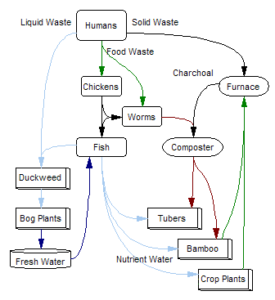The Biome
Once the habitat is constructed and they have moved in, they must set up the infrastructure for the biological elements they have carried from Earth.
There will be fish, chickens, insects, in addition to the seeds, cuttings, and small plants that will jumpstart their biome. This habitat will be much different from the space agency offerings and more like the homestead efforts of early american pioneers. There will be little hi-tech gear. Some is absolutely required, but much of what the agencies suggest is geared around keeping our astronauts safe so they can return to earth. We bear no such illusions.
Our homesteaders have engaged themselves in the process of a one-way voyage to seed a new planet with our species – and with us, we carry some of our most valuable companion species, that will support our existence while there. As the fish, chickens, insects, and plants begin to develop and grow, the team will become less dependent on their emergency air, water, and food supplies they brought with them, and within the first few months, begin to replenish those emergency supplies with new components from the pond, gardens, and chickens.
In Situ Resource Utilization
There are resources on the Moon that will serve all these components; from volatiles to manufacture rocket fuel, to the very real potential of water ice. From that water ice, not only precious water, but its components oxygen and hydrogen for fuel. Other valuable elements are abundant in the regolith we will find near our settlement. As these elements are harvested from the moon, our teams will be integrating them into the supply infrastructure. Once the settlement has procured sufficient for their own needs, then they will begin stockpiling quantities for trade with the ISS, perhaps Tiangong, and the soon to develop lunar orbit station that will be assembling the mars settlement ship. These trade arrangements will provide a source of revenue for continued support of the homestead teams, the trade between the ISS and the homesteads is a critical element in the forward progress of space settement. For without trade there can be no expansion for settlement – OR NASA.
In addition to the products and materials suggested so far by pundits and space advocates, such as Helium 3 and Platinum metals, there are other products that might qualify for export to the ISS and/or Earth. But their own list is paltry compared to the laundry list of products and services that the Homestead Settlement might offer to the ISS – or any other orbiting facility:
| Photos/videos | Air, Water, & Food Deliveries | Recycle Used Equipment |
| Silk Worm, and or silk | Fuel Production Services | Recycle Capsules & mat’ls |
| soufle’s | Laundry Services | Waste Process & Recycling |
Once the farm elements are completely setup and operating, the settlers can take a much needed rest. At this point in the process, they will be the deciding authority on future progress, for they will be the only people who know how to do it. The challenges they will have overcome by then, will make them experts in living and working on the Moon. And this experience will be invaluable as they begin planning the next phase of the mission: Establishing the Lunar Orbit Station, and working to begin ice mining, and regolith processing.
The two smaller dark craters to the east of the settlement will be their first targets in assessing the reality of ice-mining on the moon. The drilling robots will be re-configured, and pressed into service.
